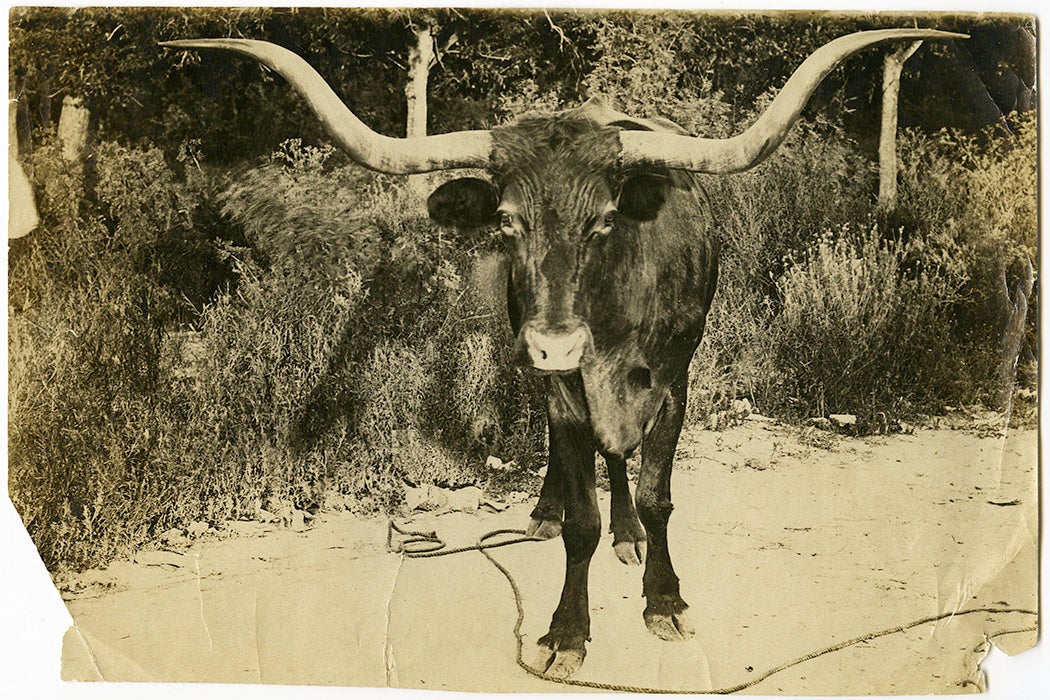When the University of Texas was no longer interested in caring for the football team’s bovine mascot in 1920, team-members and supporters dressed up like Indians and ate the longhorn steer. As historian Joshua Specht tells it, Bevo was a fine representative of the breed: intelligent, independent, and cactus-chewing tough. A descendant of cattle that fended for themselves on the open range and endured treks of hundreds of miles to railheads, Bevo had too much “pep and ginger and temper,” in the words of a contemporary, for campus life.
By 1920, cattle ranches were already a few decades past the longhorn era, preferring instead more “market-friendly” European breeds like the Hereford. Bevo was an anachronism and a curiosity—and he was killed and eaten at the dawn of the symbolic revival of the breed, as “Longhorn” and “Texas” merged into one in mythology and popular culture.
Texas Longhorns, which only got that name in the twentieth century, were “first admired, then rejected, and finally mythologized,” Specht writes. He examines them as a form of nineteenth-century biotechnology and labor. The animals were a “critical piece of a highly developed and capitalized ranching system”—about which Specht has also written a book—until they were superseded by other technologies and economies.
Longhorns developed from a mixture of breeds brought by the Spanish and then the Anglo-Americans. As Specht reminds us, all domesticated cattle descend from the now extinct Eurasian Aurochsen. Columbus’s second voyage in 1493 introduced cattle from the Canary Islands to the Americas, where “the history of cattle has been inseparable from the history of conquest.” Cattle turned into the advance front of European conquest and settlement of indigenous lands. The animals, left to themselves most of the time, turned semi-feral and self-sustaining over many generations, naturally selecting to the dry and scrubby conditions of the southwest as they moved north through Mexico.
“Ranchers appropriated—as well as encouraged—the longhorn’s adaptations as a kind of technology (or biotechnology, in evolutionary history terms) ideally suited to transforming grass into commodity beef,” writes Specht.
He notes that longhorns themselves “performed much of the labor of ranching.” Whether they were “caring for their young on the range or actually walking themselves to market—impossible for other commodities—longhorns were vital to the labor of beef production.”
“In 1870, there were nearly 15 million beef cattle, or 386 per 1000 people, nationwide,” but cattle and people were at opposite ends of the trail. Straight up from the range, longhorns were considered too lean for anything but canning, but if they were moved north to be fattened on the sweeter grass of Colorado or Wyoming for a season or two, their value increased with their weight.
For a (human) generation, the longhorn was the best solution to the distance-to-market-problem. But by the mid-1880s, ranchers were turning to other breeds. The trains were now much closer to the ranches, so rugged, long-hauling cattle were no longer necessary. The distinctive horns, great for defense in the open range, became a liability for the industry. After the economic depression of the late 1880s, Chicago was flooded with the last of the great longhorn herds, all destined for the tin.
The end of the longhorns era doesn’t seem to have been sentimentalized at the time. But decades later, the passing of the longhorn was redefined as “a tragedy rather than a business decision.” In the twentieth century, the breed became symbolic of a “simpler and more authentic West,” a virtually pre-capitalist way of life. Specht argues that such nostalgia elides the international scope of longhorn ranching. Most of the big ranches, after all, were owned by investors in the eastern US and Britain.
Weekly Newsletter
The longhorns’ passing was also compared to the passing of the bison, a notion used to naturalize cattle ranching as especially American. Which of course meant white American, no matter that cattle originated in the Old World, that ranching was pioneered by the Spanish (with their Islamic influence), and that plenty of enslaved and then free Black Americans worked as cowboys.
Texas mythology in particular focused onto the longhorn as a state symbol and a tourist attraction, even as the effort to preserve the breed in the 1920s first coalesced in Oklahoma, courtesy of members of the US Forest Service.







